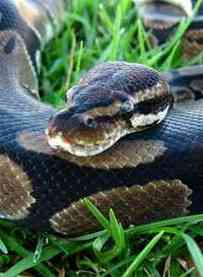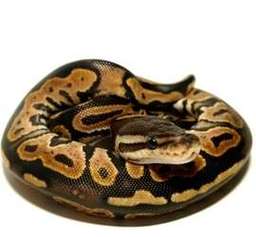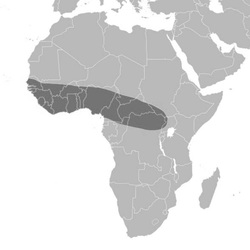Ball PythonPython regius |

Custom Search
|
|
The Ball Python (Python regius) can be found in West and Central Africa, reaching from Uganda and South Sudan and west through Nigeria and into Liberia, Guinea, and Sierra Leone. Its massive range includes many countries like the Central African Republic, Cameroon, Benin, Congo, Côte d'Ivoire, Senegal, Gambia, Ghana, Guinea-Bissau, Mali, Niger, Sierra Leone, and Togo.
They inhabit savannas and deforested areas and usually prefer locations near water. This species can also be found in agricultural lands where it performs an important role in rodent pest control. Occasionally there have been found some specimens in the Florida Everglades, probably escaped or released pets. But unlike other invasive snakes in Florida, such as the Burmese Python (Python bivittatus), Ball pythons have not yet an established population in the Everglades. This snake species when in a defensive posture, coil themselves, with the head protected in the middle, almost like a ball, from this behavior derives their common name, Ball Python. Their other common name royal python comes from their use by Cleopatra who is believed to wore them as bracelets on her wrists. Another common myth about Cleopatra is that she took her life by letting a deadly venomous snake bite her, most likely the Egyptian cobra (Naja haje). The Ball python can measure up to 6 feet (1.8 m) long, but on average they do not exceed 4 feet (1.2 m) in length and about 2 kg in weight, thus making it the smallest of all the African pythons. Usually, females are larger than males. In diameter they will reach around 10 to 15 cm. There are no recognized subspecies. Being smaller and one of the most inoffensive and less aggressive python snake species known, means it can be easily handled, making it ideal for those who want an exotic pet snake. However, its popularity among snake fans resulted in massive captures in the wild this species for its holding in captivity. The Ball Python head is oval-shaped and narrow, this snake has a narrow neck, a solid body, and a relatively short tail. Their skin color is a shade of dark brown in the background with a pattern of round spots of golden yellow color, and a cream or whitish underside.
The color and pattern may also present many genetic variations called morphs among snake lovers, such as Albino, Piebald, Leucistic, Spider and many others, these are obtained through selective breeding, for the exotic pet industry. Some of these color morphs some can reach several thousand dollars for a specimen. In general this species lives about 20 years, however, a male in the Philadelphia Zoo in the US lived for 47 years in captivity. The Ball Python has mainly nocturnal habits and uses rock crevices, hollow tree trunks or holes in the ground during the day to take refuge, they are also excellent climbers. All the pythons are non-venomous snakes that use constriction to kill their prey, by holding them with their jaws and coil their body around them, immobilizing and squeezing the prey until it dies from asphyxiation. Subspecies / Taxonomy
There are no subspecies currently recognized for the Ball python. Diet / Feeding The Ball Python feeds mainly on small mammals and rodents found in their habitat, like shrews, striped mice and African soft-furred including rats. Young snakes are known to occasionally feed on birds. Reproduction The Ball Python is an oviparous species, its breeding season occurs from December to January, and the eggs are laid from February to April. During the approximately 2 months incubation period, the female won't feed and stays coiled around the eggs, and through contractions of its muscles is able to increase the temperature of the eggs. The clutch is approximately from 5 to 10 eggs, but they only reproduce once every 2 or 3 years. At birth, the young are between 7 to 12 in (20-30 cm) in length, they receive no parental care and need to fend for themselves from birth. In this snake species, sexual maturity is reached at the age of 2,5 to 3,5 years, but age is only one of the factors determining the snake sexual maturity and ability to breed. Their weight also plays an important role in breeding ability, with females breeding for the first time with a weight as low as 800 g and males even lower at 600 g. Conservation / Threats The species is not globally threatened according to the International Union for Conservation of Nature and has been assessed as a "Least Concern" species. It is included in Appendix II of CITES, and their capture for the illegal trade of exotic species and the hunt for the skin trade are the main threats. Improving captive breeding strategies may help in reducing the pressure that the pet trade puts on the species. It is one of the most common snake species found in the exotic pet trade. The ball python makes an excellent pet because they are inexpensive, usually have a good temperament, and their long life span makes them one of the most common pet snakes.
|
Did You Know?
Snakes don't have eyelids to protect their eyes,find some amazing snake facts for kids. Scientific classification |
© 2014 Snake Facts About Us | Privacy Policy | Contact





